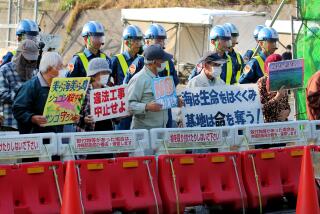Japan’s Military Gets It Right
Slipping by almost unnoticed during the United States’ dramatic war in Afghanistan was the reemergence of Japan into world politics.
On Nov. 25, Japan dispatched a destroyer, a minesweeper and a supply ship--all flying the once-hated Rising Sun flag--to the Indian Ocean in support of the U.S. campaign against terrorism. Carrying humanitarian supplies, the warships were authorized to fire if attacked.
It took the attacks of Sept. 11 to persuade the Japanese to shake off, at least partially, the shackles imposed on it by Article 9 of the “peace constitution” foisted upon them half a century ago during the U.S. occupation. This utopian article pledged Japan to “forever renounce war ... and the use of force” to settle international disputes.
Like peoples everywhere, the Japanese were shocked by the brutal assault on the World Trade Center and the Pentagon, but Japan was especially shaken by the frequent comparisons of Sept. 11 to the Pearl Harbor attack that propelled the U.S. into World War II. After this one-two punch, Japan quickly broke with its postwar past.
This remarkable decision was not easy for Tokyo, given the persistent pacifist mood encouraged by Article 9 and reinforced by continuing resentment over the atomic bombings of Hiroshima and Nagasaki.
In a 1965 address to Japan’s National Defense College faculty, I shocked my hosts by criticizing Article 9, which prohibits Japan from deploying troops abroad. I argued that Japan could not become a responsible world power unless it increased its defense budget and accepted a larger military role in the world. I had the temerity to suggest that Tokyo provide military personnel as U.N. peacekeepers in the Middle East.
My advice was premature, but 26 years later, in 1991, after bitter internal controversy, Tokyo did send 500 Self-Defense Force members to the Middle East to serve in a United Nations peacekeeping mission after the Gulf War. Oil-dependent Japan also contributed $13billion to Desert Storm. The following year, Japanese army engineers were sent to Cambodia to join another U.N. force. They were the first Japanese soldiers in 47 years to set foot in Southeast Asia, where memories of the brutal Japanese conquest are still raw.
But Sept. 11 forced the Japanese to make a much bolder move. Under pressure from Washington and Prime Minister Junichiro Koizumi, the parliament passed a strong anti-terrorism law Oct. 29, enabling Japan to contribute to “efforts of the international community for the prevention and eradication of terrorism.” And 83% of Japanese citizens approved.
The dispatch of warships to the Indian Ocean is a small but significant step in Tokyo’s cautious efforts to modify Article 9. As the vessels were about to leave port, a few dozen protesters appeared carrying antiwar banners. But they were dwarfed by public figures giving patriotic speeches and tearful families waving goodbye.
This was a far cry from the decades of antiwar and anti-nuclear demonstrations that have dogged the prime ministers who sought to shake off the dangerous restraints on Japan’s capacity to accept a larger military burden. Shigeru Ishiba, a member of parliament, recently said, “Under the U.S.-Japan Security Treaty, America protects Japan, but Japan does not protect America.”
Even opposition Liberal Party leader Ichiro Oza said that Japan should change the constitution and codify its right to fight alongside its allies but acknowledged that politicians are still too timid to take this step.
Although it continues Japan’s military ambivalence, the new anti-terrorism law signals a willingness to play a more robust role in the U.S.-Japan alliance that seeks to maintain peace in the Pacific and beyond. Parliament’s decision also suggests that Japan, a great economic power, is coming of age as a civilized military power.
As President Bush put it aboard the aircraft carrier Enterprise on Dec. 7, “There is a great divide in our time; not between religions and cultures but between civilization and barbarism.”
*
Ernest W. Lefever is a senior fellow at the Ethics and Public Policy Center in Washington, D.C.
More to Read
Sign up for Essential California
The most important California stories and recommendations in your inbox every morning.
You may occasionally receive promotional content from the Los Angeles Times.










